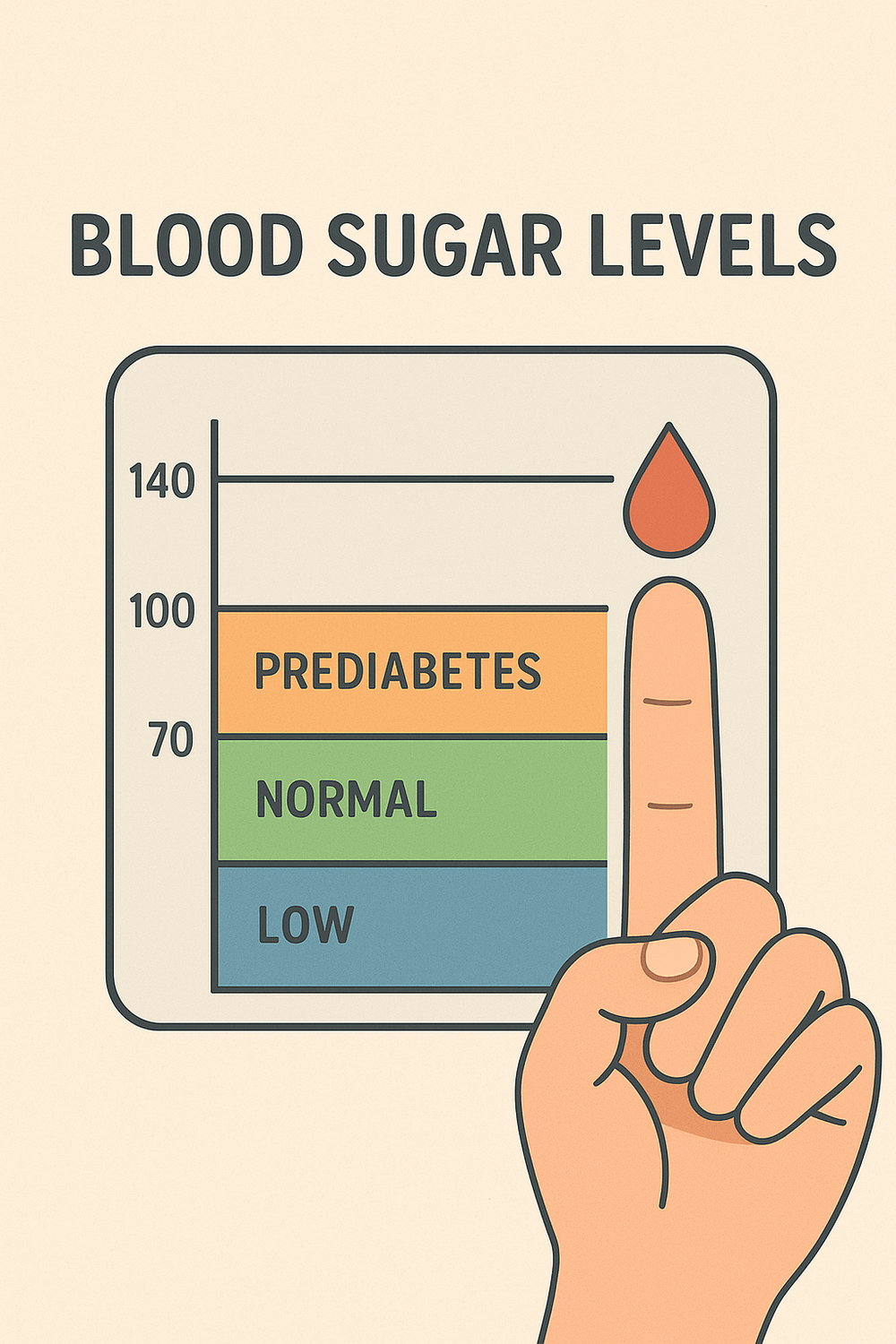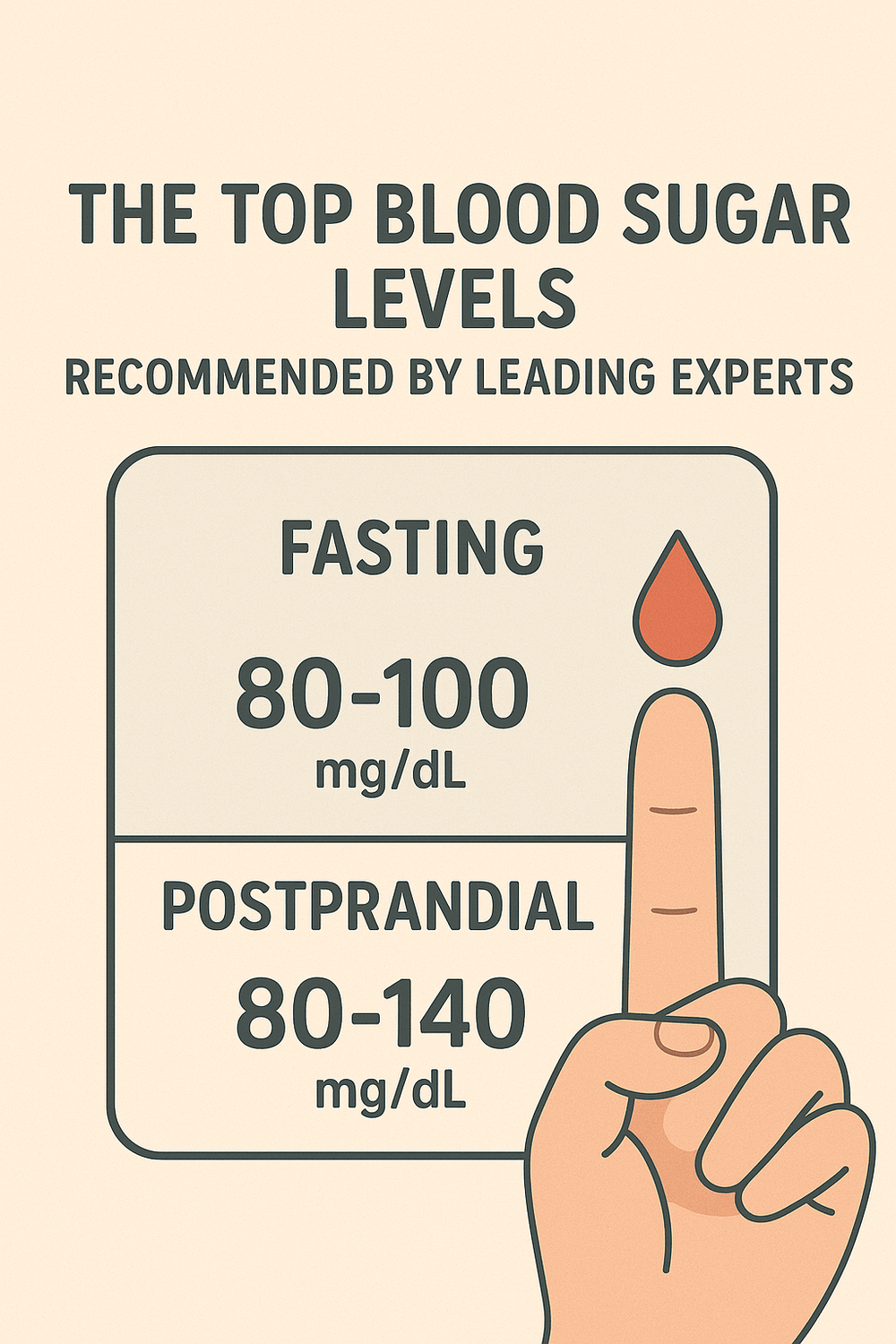Product Guide
The Top Blood Sugar Levels Recommended by Leading Experts
The quick-glance targets (for most non-pregnant adults with diabetes)
A1C: generally <7% (individualized).
Before meals (pre-prandial): 80–130 mg/dL (4.4–7.2 mmol/L).
1–2 hours after starting a meal (post-prandial): <180 mg/dL (<10.0 mmol/L).
CGM Time-in-Range (TIR): ≥70% of readings between 70–180 mg/dL (3.9–10.0 mmol/L); keep time <70 mg/dL under 4% and <54 mg/dL under 1%.

What counts as “normal,” “prediabetes,” and “diabetes”?
If you’re screening (you don’t already carry a diabetes diagnosis), these diagnostic cut-offs apply:
Fasting plasma glucose (FPG):
Normal: ≤99 mg/dL (≤5.5 mmol/L)
Prediabetes: 100–125 mg/dL (5.6–6.9 mmol/L)
Diabetes: ≥126 mg/dL (≥7.0 mmol/L)
2-hour OGTT (after 75 g glucose):
Prediabetes: 140–199 mg/dL (7.8–11.0 mmol/L)
Diabetes: ≥200 mg/dL (≥11.1 mmol/L)
A1C:
Prediabetes: 5.7–6.4%
Diabetes: ≥6.5%
Random plasma glucose with classic symptoms: ≥200 mg/dL (≥11.1 mmol/L) = diabetes.
Why it matters: catching prediabetes early gives you the best chance to reverse or delay progression.
ADA vs. AACE targets—what’s the difference?
Two major groups guide glucose goals:
ADA (American Diabetes Association) recommends A1C <7%, pre-meal 80–130 mg/dL, and post-meal <180 mg/dL for most non-pregnant adults—again, individualized.
AACE (American Association of Clinical Endocrinologists) supports tighter goals when safely achievable (e.g., A1C ≤6.5%, pre-meal <110 mg/dL, post-meal <140 mg/dL) and allows 7–8% if there’s high hypoglycemia risk, comorbidities, or limited life expectancy.
In practice: many people start with ADA targets; if glucose is stable without hypos, some clinicians may safely aim closer to AACE numbers.
Why people love it: TIR captures real-life swings (meals, workouts, sleep) and helps you fine-tune therapy, beyond a single A1C.
Special situations that change the target
Pregnancy (gestational diabetes or diabetes in pregnancy)
Fasting glucose: <95 mg/dL (<5.3 mmol/L)
1-hour post-meal: <140 mg/dL (<7.8 mmol/L) or 2-hour: <120 mg/dL (<6.7 mmol/L)
CGM pregnancy goals: sensor range 63–140 mg/dL (3.5–7.8 mmol/L) with most readings inside that band.
These stricter limits lower risks for the baby (e.g., large birth weight) and the mother. Always individualize with your obstetric and diabetes teams.
Older adults, significant comorbidities, or high hypo risk
A less stringent A1C (often <8%) may be safer to reduce hypoglycemia and treatment burden; treatment should not be automatically “de-intensified” if someone is stably achieving A1C 6–7% without lows.
Children and teens with type 1 or type 2
Targets are individualized, often aligning with adult TIR goals and emphasizing safety around activity (e.g., recommended pre-exercise ranges). Discuss exercise-specific plans with a pediatric diabetes team.
When numbers are very high
Exceptionally high results may warrant urgent intensification or insulin:
Many clinicians initiate insulin when BG ≥300 mg/dL (≥16.7 mmol/L) or A1C >10%, especially with symptoms. Seek prompt medical guidance.
Converting units (mg/dL ↔ mmol/L)
Meters and apps may show mg/dL (U.S.) or mmol/L (most other countries).
Quick math: mmol/L = mg/dL ÷ 18; mg/dL = mmol/L × 18.
Putting targets to work: an example day
Here’s what a “good day” might look like for a non-pregnant adult with diabetes using ADA goals:
Wake-up (fasting): 95–110 mg/dL (5.3–6.1 mmol/L)
Pre-breakfast: 90–120 mg/dL (5.0–6.7 mmol/L)
1–2 hours after meals: usually peaking under 180 mg/dL (<10.0 mmol/L)
Overnight: CGM spends most hours between 70–180 mg/dL, with minimal time below 70 mg/dL.
Adjust food timing, medication, and activity with your care team to nudge these patterns in range.
A1C vs. average glucose: how they relate
Lab A1C gives a 2–3 month view. You can translate it into estimated average glucose (eAG) using:
eAG (mg/dL) = 28.7 × A1C − 46.7. (To get mmol/L, divide eAG by 18.)
Example: A1C 7% ≈ eAG 154 mg/dL (8.6 mmol/L). That aligns with ADA’s typical targets.
Practical tips to stay in range
Use your meter/CGM trends, not just single numbers. Watch patterns before breakfast and 1–2 hours after meals.
Match carbs to meds and movement. Consistent carb portions and post-meal walking can blunt spikes (ask your clinician for a personalized plan).
Review lows first. Preventing hypoglycemia comes before tightening highs; then aim for TIR ≥70%.
Re-check targets as life changes. Pregnancy, new meds, travel, illness, or aging can shift ideal goals.

Bottom line
For most non-pregnant adults with diabetes, leading groups advise A1C <7%, pre-meal 80–130 mg/dL, post-meal <180 mg/dL, and CGM TIR ≥70% (70–180 mg/dL).
Pregnancy requires tighter limits (fasting <95, 1-hr <140, or 2-hr <120; CGM 63–140 mg/dL).
AACE supports tighter goals when safe and looser goals when needed—your plan should be individualized.
This guide is for general education. Always confirm your personal targets with your healthcare team—especially if you’re experiencing frequent lows, readings consistently above 300 mg/dL, pregnancy, or major health changes.
HEY, I’M AUTHOR…
Platform for Health, Electronics, Home & Kitchen, Clothing etc related News. We are determined to bring you the scoop of the media and latest trends here everyday, round the clock.
JOIN MY MAILING LIST
Created with © systeme.io


